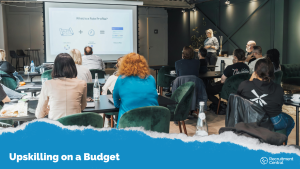The talent crisis is not looming – it’s already here. In 2025, nearly one in four workers will quit their roles, making talent retention a top priority for every organisation. Turnover worldwide is increasing too, particularly in certain sectors. For instance, the Professional Services sector recently reported a turnover rate of 63%.
This is a fundamental problem for employers struggling with severe skill shortages and an increasingly competitive recruitment landscape.
But retention issues are not just an “HR problem.” Behind each resignation sits a complicated web of lost productivity, disrupted client relationships, hiring delays, and rising recruitment costs.
According to SHRM, the average cost of replacing an employee is between 50% and 200% of their annual salary, depending on their role and level of seniority. Multiply that by multiple resignations each year, and you have an enormous expense.
Beyond that, when teams constantly change, institutional knowledge erodes, employee morale plummets, and service delivery rates suffer.
Fortunately, moments of crisis often also introduce opportunities. Organisations that treat retention as a priority can gain a genuine competitive advantage. The companies that thrive in 2025 and beyond might not be the ones with the biggest talent budgets.
They could be the businesses focusing on engaging, supporting, and developing their teams. Think of it this way – McKinsey says 87% of organisations are already facing skill gaps. What if you focused on keeping the talent you already have, rather than constantly seeking new staff?
This guide will be your practical playbook for turning the tide, tackling turnover, and boosting engagement. We will explore why retention is your secret weapon for resilience and success in a complicated talent market and give you the strategies you need for sustainable growth.
Understanding the 2025 Talent Retention Landscape
Shifting attitudes make employee retention one of the most important challenges and opportunities for leaders in 2025. Many companies today feel like they are facing an uphill battle searching for talent. However, the complicated hiring space is not just a result of employees demanding “more” from employers. Many professionals today are struggling, too. They feel stuck, undervalued, and unsure of what’s coming next in their industry.
Around three-quarters of Australian professionals say they’ll be looking for a new job this year, but only 48% feel confident about the opportunities in their sector.
The White-Collar Recession
In uncertain markets, transparent leadership and development opportunities play a major role in retaining top talent and rebuilding trust. The world is changing faster than we can react. Just look at the emerging “white collar recession.” In the last couple of years, professionals in industries like technology and law have started dealing with huge layoffs, created partly by a growing number of companies replacing workers with AI to cut costs. In 2024, 40% of white-collar workers said they didn’t land a single interview despite their skills.
When workers face layoffs in traditionally “secure” sectors, panic emerges. For many employees, hearing that AI can do “parts of your job” creates uncertainty and, at times, fear. Without transparent communication about how roles will evolve and how employees will be supported through retraining, workers can begin to see themselves as temporary placeholders – biding their time until a computer takes their role.
No wonder employees are thinking about jumping ship before they drown.
Rethinking the Employee Value Proposition
Although employees increasingly worry about “AI job displacement,” employers still demand more. A strong wage isn’t enough to guarantee loyalty anymore. Gartner found that most employees believe they should be growing faster than they are and accessing more development opportunities.
Employees are prioritising growth and development because they know in-demand skills are quickly changing. Beyond that, many professionals, especially younger millennials and Gen Z employees, see their job as an extension of their identity. They want to contribute to companies with missions they respect and to see a clear path forward for themselves in that environment.
Today’s employee value propositions must go beyond salary and health benefits and deliver a comprehensive combination of opportunity, meaning, and psychological safety in the workplace.
Wellbeing is Now a Dealbreaker
Strong wellbeing programs are now essential for long-term talent retention. Wellbeing has evolved from a post-pandemic buzzword into something every candidate wants to pursue, and it makes a real difference in hiring and retention.
The reality is that today’s employees are exhausted, overwhelmed by uncertainty, changing work experiences, and new technology. According to Deloitte, 77% of employees report experiencing burnout in their current roles, and mental health is now cited as one of the top three reasons for leaving an employer.
That is why top employers are investing in holistic wellness programs that focus on physical and mental wellbeing. They are exploring more manageable workloads, training leaders to be more empathetic, and introducing flexible scheduling opportunities to avoid losing talent.
The Foundation – Employee Engagement Strategies
So, how do companies retain top talent in this environment? It all starts with engagement. Engagement is a company’s heartbeat – driving innovation, motivation, and resilience. But it is incredibly difficult to build and preserve.
Gallup says that only around 23% of employees worldwide are actively engaged, but companies with engaged workers are also 23% more profitable.
Plus, there is a clear connection between engagement and retention. Engaged staff feel a sense of ownership and pride in what they do, making them far less susceptible to the lure of other offers.
The opposite is also true. When people feel disconnected from their work, they do not just become less effective, they become flight risks. And in 2025’s hypercompetitive, skills-scarce labour market, that risk can turn into reality fast.
So, if you want your people to stay, give them a reason to care about their roles.
Making Work Meaningful
One of the most powerful ways to boost engagement is to give your team members a purpose. People want meaning in their work – they want to feel like what they are doing everyday matters, particularly when AI is automating more tasks.
So, how do you make work feel meaningful?
First, make your mission clear in everything you do. Highlight your focus whenever you assign tasks, communicate goals, and recognise achievements. Tie tasks to bigger outcomes. For instance, at a consultancy helping nonprofits refine their fundraising strategies, you might remind team members that their analytics support critical community services.
Go a step further with “job crafting.” Encourage employees to mould parts of their jobs to match their passions or strengths. That could mean a project manager with a creative streak takes on content creation for marketing, or a data analyst with people skills helps train new hires.
It is all about empowering employees to architect their work experience rather than forcing them to follow along.
Plus, remember that purpose also comes from growth. Motivation, engagement, and meaning dwindle when opportunities to develop and grow are limited or unclear. Get experimental. Offer employees various learning opportunities, from mentorship programs to micro-credentials. Work with each staff member to create a personal learning pathway aligned with their professional goals.
Building a Culture of Recognition
Recognition plays a direct role in improving engagement and retaining talent, employees need recognition to feel engaged. Everyone wants to feel seen and appreciated for what they do. Gallup even found that employees who feel regularly recognised are four times more likely to be engaged, and 63% more likely to stay.
Unfortunately, many leadership teams struggle to find the time to commend their teams or offer feedback properly. Recognition quickly becomes a once-in-a-while treat, such as an employee of the month celebration or an occasional pizza day.
Take a more proactive approach to acknowledging your staff. Use recognition platforms (digital or in-person notice boards) to create a space for constant feedback and peer nominations. When you commend a team member for something, be specific.
Do not just say, “You did a great job.” Say, “Thanks for staying late to finalise that client pitch. It made a big difference to our proposal’s success.”
Build a culture of recognition that encourages employees to pat each other on the back. Consider apps or internal channels that let employees give each other “kudos” or “gold stars” for a job well done. This will make team members happier and create a more supportive company culture where everyone feels aligned.
Do not underestimate the value of informal, in-the-moment recognition, either. A quick thank-you or a note acknowledging someone’s growth can make a huge difference. Rewarding your employees does not have to mean giving them huge bonuses or hosting constant office parties.
Skill Development and Career Progression
Want to know what the top cause for talent turnover is expected to be in 2025? Lack of development opportunities. Seventy percent of staff say they would be somewhat likely to leave their job if they could see an opportunity for progression elsewhere.
Growth pathways are a big driver of talent retention in 2025.
While many staff members have always valued growth, the changing workplace is increasing demand for skill development. Many employees are now worried that their abilities will no longer be relevant in the next few years.
According to LinkedIn’s Work Change Report, job skills will shift by about 70% by 2030. For employers, that is a threat and an opportunity.
Failing to keep your workforce up to date can create massive internal skills gaps. On the other hand, a robust learning and development (L&D) culture becomes a magnet for talent.
Bridging the Gap: Constant Learning That Keeps People
The demand for new skills is growing, yet most employees do not feel their organisation can keep up. LinkedIn’s report found many companies do not even reach the “measurement” stage of figuring out which skills they need to develop.
This means that employees stagnate, and businesses are left with growing skills gaps in crucial roles. Instead, companies need to find a way to embed learning into the workflow. Consider adding microlearning opportunities to current projects or giving staff on-demand access to skill-building resources and mentorship programs.
Companies like Unilever, for instance, build internal talent marketplaces that match employees with real-time learning, gigs, and stretch assignments based on skill and interest, not just job title.
Take advantage of real-time feedback, too. Tools like Slack or Microsoft Teams can host dedicated channels where employees share industry articles, tips, and resources. This is peer-driven learning, happening organically as part of work.
Creating Career Paths in an Uncertain World
Traditional career ladders are giving way to lattices or even “jungle gyms,” where employees might move laterally, diagonally, or in short bursts upward. Unfortunately, many employees still feel stuck, unsure how to move forward when the next step is not clear.
So, develop new career pathing strategies that reflect the current workplace. Design skill matrices that visually show employees how to move from their current roles into new projects or functions. Design internal mobility frameworks that make it easier for staff to explore different “branches” based on their passions and abilities.
Commit to having regular conversations with team members, asking managers to meet with staff to update and rework their development paths regularly. Do not make it difficult for team members to see a future with your organisation.
Embracing the Rise of “New-Collar” Talent
The “new-collar” hiring trends reflect a growing shift towards hiring employees based on their actionable skills rather than traditional credentials. For instance, IBM promoted this idea by showing that many technology roles could be filled by people without degrees who received the right training.
This trend is already gaining momentum. Fifty-nine percent of employers hired new-collar talent in the past year. New-collar employees are adaptable, motivated, and keen to prove their value, but they also need tailored support to succeed in their roles.
This means many companies will need to rethink their approach to onboarding, mentoring, and even reviewing the performance of new employees. There needs to be a focus on learning agility and constant growth, rather than legacy experience.
You will also need to ensure that advancement is not based entirely on a person’s background and experience. When skills become the basis for opportunities, employees and companies win, because teams can grow and evolve much faster.
Compensation and Benefits Strategies for Retention
Candidates have many priorities in 2025, but salary still matters.
In 2025, employees have become more discerning about total compensation packages, factoring in the size of the paycheque and the quality and breadth of benefits. They are evaluating if the employment experience is truly worth it, especially under mounting pressures like cost-of-living increases and job uncertainty.
Beyond Base Salary: The Power of Total Rewards
To retain talent today, businesses need to think beyond base salary. For many, this means taking a total rewards approach – bundling bonuses, health coverage, pension contributions, and benefits with salary opportunities.
Transparency and clarity are important here. Employees who cannot understand the full package they are getting are less likely to trust you, which means they are more motivated to start shopping around for a better deal. Sharing salary bands, bonus structures, and promotion requirements helps build trust with your workers.
Even more important? Pay equity. Today’s candidates value diversity, equity, and inclusion, and failing to pay one demographic group the same as another could land you in hot water with regulators. Conduct regular audits to make sure your salaries are fair.
The Benefits That Matter Most This Year
Benefits are important this year, particularly if you want to retain your employees. While the types of benefits your employees value can vary, many modern workers are looking for things like private health insurance, bonus schemes, and pension contributions.
However, they are also looking for more versatile, non-monetary incentives. Recognition programs constantly drive engagement and loyalty. Experiential rewards, such as access to leadership coaching or learning budgets, are also gaining traction.
As employees look for flexibility and work-life balance, they also demand more time-based rewards, like additional days on leave or the chance to work reduced hours on certain days.
The key to creating a successful benefits strategy is personalisation. Connect with each of your staff members and find out what matters most to them, caregiving leaves or access to coaching platforms.
Talent Retention in the Age of AI and Technological Change
Artificial intelligence, automation, and world-changing technologies are everywhere. They might be boosting productivity, efficiency, and even creativity in some sectors, but they are also raising worrying questions for employees, like “Will I be replaced by a machine?”
It is not just team members responsible for repetitive tasks like data entry who are nervous. Many roles are in flux as intelligent systems become more sophisticated.
If organisations do not address their employees’ fear that they are running on borrowed time, they invite disengagement and attrition.
Supporting Employees Through Digital Transformation
Change fatigue is becoming a real problem. After several years of constant upheaval, employees are tired of the ground shifting beneath their feet. They want to see evidence that their employers will help them adapt and stay relevant.
The easiest way to get started is with holistic upskilling and reskilling strategies. Take a future-focused approach, helping employees understand things like data analysis, AI collaboration, and automation. Figure out what skills your teams will need in the future and ensure they can develop them with workshops, project-based learning, and mentorship.
Remember, do not just focus on digital skills or technical abilities either. The best upskilling programs should also invest in human skills like adaptability, critical thinking, and collaboration.
Throughout this process, consider carefully preserving psychological safety. Uncertain employees will need a space where they can voice their concerns, ask questions, and even make mistakes when they are learning how to adapt.
Ensure managers and leaders accommodate this, championing constant learning and acknowledging the emotional impact of regular change.
AI as a Retention Tool
It sounds unusual, but the same technology that is threatening some roles can also help to boost retention when used strategically. For instance, many organisations are using AI and predictive analytics to help them identify which employees are most at risk of leaving, based on engagement metrics and performance data.
These insights can help managers intervene early with targeted support. AI also paves the way to more personalised career development opportunities. Based on data, AI tools can suggest next steps for an employee’s skill growth or identify ideal mentorship matches.
Conversational AI can even enhance employee experiences across the board, helping to answer HR queries, simplify access to benefits information, or support onboarding strategies. AI tools can also help employees become more effective and efficient, taking over the menial work of their day-to-day roles so they can focus on tasks with meaning.
Ethical Considerations: Maintaining Trust
Most companies today will embrace AI to some extent. However, employees will not be happy if they view technology as making their roles obsolete.
Ultimately, committing to transparency is the only way to get everyone on the same page and inspire positive change. That means explaining how AI tools work, what data they use, how decisions are made, and their impact on roles. Employees do not need full technical details but clarity, honesty, and an opportunity to respond.
Additionally, maintain a human-first approach. Remember that AI should augment human abilities – not replace them. If AI-driven efficiency means reduced operational costs, funnel those resources into improved learning opportunities and better benefits. Show your team members that you are putting them first.
Implementing a Comprehensive Retention Strategy
It is one thing to know why employees are leaving your business and even what programs and perks would convince them to stay. It is another to put together a strategy that proactively improves retention.
As more employees continue to quit and seek better opportunities, you cannot just react to each exit interview. You need a consistent, dynamic plan.
Assessing Your Current State
Every great strategy starts with a clear view of your position. Many companies with a “retention problem” do not spend enough time drilling into the details.
Give yourself a data-driven edge. Review your attrition data over the last twelve to twenty-four months, breaking it down by department, role, tenure, demographics, and anything else you can think of. Look for patterns or themes, like certain groups leaving faster than others.
Remember, numbers alone will not tell the full story. To understand the full reason behind attrition, you need to listen to your employees. Use pulse surveys to spot early exit warning signs.
Building Your Retention Roadmap
Start by identifying your top retention risk factors, such as lack of flexibility, career growth, or manager support. Then, start building your retention roadmap.
For instance, if you discover that exit interviews frequently highlight issues with poor management, your first step might be investing in frontline leadership training. Launch a talent marketplace to connect people with new opportunities if internal mobility is low.
Each initiative needs a clear person or team to manage it. Retention is not just HR’s job, it is a shared responsibility across leadership, people managers, and team leads. Assign specific actions to stakeholders and bake accountability into performance reviews and team OKRs.
Measuring What Matters
Finally, do not wait until the end of the year to see whether your strategy is working. Build in mechanisms to measure progress constantly. Identify valuable indicators of a successful strategy early on and watch them constantly. Metrics might include:
- Retention rate (especially among high performers)
- Voluntary vs. involuntary turnover
- Engagement and wellbeing scores
- Internal promotion rate
- Participation in learning and development
- Manager effectiveness ratings
- Mobility and career progression stats
Watching real-time data, like sentiment or engagement scores, can also help you adjust proactively. Plus, it can help you benchmark your performance against your competitors, looking at how your retention rates and satisfaction levels compare across the industry.
No single trick or quick fix can solve the retention crisis that companies face today. Real success comes from creating a workplace that people choose to return to, day after day, and year after year.
This means focusing on boosting engagement, delivering flexibility, investing in development opportunities, providing comprehensive rewards packages, and carefully adopting AI.
It might seem like a lot of work, but investing in the right retention strategy now is the best way to avoid the challenges of a complex talent market and prepare your company for future growth. You cannot succeed without the right talent, so do not make the mistake of losing the valuable employees you already have.
Organisations that invest in retention now will be the ones that future-proof their teams, preserve institutional knowledge, and deliver consistent performance over time. Those that do not risk losing not just talent, but also momentum, reputation, and resilience.
Looking for extra support to improve your recruitment and hiring process?
Explore our Employer Resources Hub for hiring strategies, templates and proven best practices.
Discover how to streamline hiring without losing quality in our Hiring Fast Without Compromise case study, stay ahead by subscribing for monthly insights, industry data and recruitment trends here.
For further leadership and organisational development support, visit this page.


















